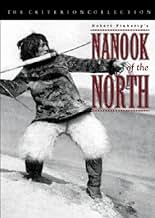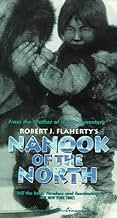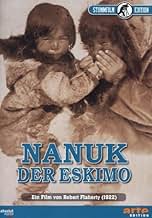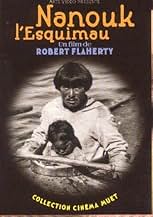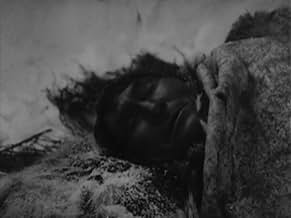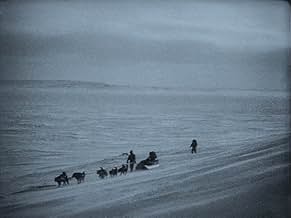NOTE IMDb
7,6/10
14 k
MA NOTE
Dans cet ancêtre silencieux du documentaire moderne, le cinéaste Robert J. Flaherty passe un an à suivre la vie de Nanook et de sa famille, des Inuits vivant sur le cercle arctique.Dans cet ancêtre silencieux du documentaire moderne, le cinéaste Robert J. Flaherty passe un an à suivre la vie de Nanook et de sa famille, des Inuits vivant sur le cercle arctique.Dans cet ancêtre silencieux du documentaire moderne, le cinéaste Robert J. Flaherty passe un an à suivre la vie de Nanook et de sa famille, des Inuits vivant sur le cercle arctique.
- Réalisation
- Scénario
- Casting principal
- Récompenses
- 2 victoires au total
Avis à la une
When looking back to the first documentary feature ever made, Nanook of the North comes up quick. Created by Robert Flaherty between 1916 and 1921 (mainly due to technical issues), the film was praised for being the first non-fictional feature ever made, in addition to capturing the unique lives of native eskimos that audiences at the time would not have expected. Part of that has to do with how much Flaherty worked so painfully hard to pull the whole thing together for so many years, all with the cooperation and patience of his subject, Allakariallak (a.k.a. Nanook). However, that in turn creates a massive conflict with this feature, being that it might not be as factually accurate as you think.
You see, even though the film documents the everyday actions of the Iniut people far up North, Flaherty actually took some creative liberties when crafting the film. In addition to the titular character not actually carrying the name Nanook in real life, his wives were actually played by Flaherty's real life wives, and even the weapons used in the film were not what the natives of the land really used. Allakariallak was actually quite accustomed to hunting with guns rather than spears. Also, the famous comical gramophone scene was all scripted, down to Allakariallak actually knowing what that type of machine was in real life. It really paints an inaccurate and frankly dishonest way of living through people who might not have even been known to international audiences any way.
However, despite the untrue facts shown throughout, the film still works well as a tale of bravery and innovation of the Inuit people up north. Many scenes are quite fascinating to view, including some of the hunts and even how the family operates. Regardless if several sequences were staged or not, much of what happens throughout the film inflicts a unique perspective of foreigners who may live differently from others. The very fact that Allakariallak spent his life around this region displays an earnest respect for both his people and the art of filmmaking in capturing such raw moments in a land one would never consider offering much. In a way, Flaherty wanted to document whilst simultaneously experimenting with the resources around far Northern Canada without degrading the virtues of eskimo livelihood.
So even if it may not be sophisticated in every single aspect, Nanook of the North still does a pretty good job in representing what residing up in a distinct region could be like. Sure, the film's flaws may anger those looking for pure facts, but in doing so, you'd fail to realize how much of a love letter the film is to a unique culture you may not have known about to begin with. Yes, it may not be completely right, but it at least presents itself through innovative craftsmanship unlike anything seen before its time. Besides, Flaherty has stated that much of what ended up in the film was conjured up through years of experimenting and well earned research of where he was shooting. I'm sure what he did is not too far off from what many filmmakers have done since then.
You see, even though the film documents the everyday actions of the Iniut people far up North, Flaherty actually took some creative liberties when crafting the film. In addition to the titular character not actually carrying the name Nanook in real life, his wives were actually played by Flaherty's real life wives, and even the weapons used in the film were not what the natives of the land really used. Allakariallak was actually quite accustomed to hunting with guns rather than spears. Also, the famous comical gramophone scene was all scripted, down to Allakariallak actually knowing what that type of machine was in real life. It really paints an inaccurate and frankly dishonest way of living through people who might not have even been known to international audiences any way.
However, despite the untrue facts shown throughout, the film still works well as a tale of bravery and innovation of the Inuit people up north. Many scenes are quite fascinating to view, including some of the hunts and even how the family operates. Regardless if several sequences were staged or not, much of what happens throughout the film inflicts a unique perspective of foreigners who may live differently from others. The very fact that Allakariallak spent his life around this region displays an earnest respect for both his people and the art of filmmaking in capturing such raw moments in a land one would never consider offering much. In a way, Flaherty wanted to document whilst simultaneously experimenting with the resources around far Northern Canada without degrading the virtues of eskimo livelihood.
So even if it may not be sophisticated in every single aspect, Nanook of the North still does a pretty good job in representing what residing up in a distinct region could be like. Sure, the film's flaws may anger those looking for pure facts, but in doing so, you'd fail to realize how much of a love letter the film is to a unique culture you may not have known about to begin with. Yes, it may not be completely right, but it at least presents itself through innovative craftsmanship unlike anything seen before its time. Besides, Flaherty has stated that much of what ended up in the film was conjured up through years of experimenting and well earned research of where he was shooting. I'm sure what he did is not too far off from what many filmmakers have done since then.
This is a fascinating documentary from Robert Flaherty, a very prolific director of early documentaries. He follows the adventures of the Eskimo Nanook, and we get to see what life was like for the Eskimo in the early 20th Century as we watch Nanook with his family, hunting for food, and building igloos.
This is really amazing stuff for 1922. It feels like it could have been made long after that. That's probably due to the fact that it relies on real settings and real people. It's not bound by the restrictions of manufactured sets, costumes, etc. of the period. However, though it looks utterly authentic, don't be fooled into thinking that Flaherty gives us a purely realistic snapshot of Eskimo life. He planted the early seeds of reality t.v. with this film, making careful use of editing to create a narrative with all of the melodramatic trappings of any studio picture. Though it's a fascinating film, it's also a reminder that documentary film is just as manipulative as fiction, and that Michael Moore wasn't the first to corner the market on presenting fiction as fact.
Grade: A
This is really amazing stuff for 1922. It feels like it could have been made long after that. That's probably due to the fact that it relies on real settings and real people. It's not bound by the restrictions of manufactured sets, costumes, etc. of the period. However, though it looks utterly authentic, don't be fooled into thinking that Flaherty gives us a purely realistic snapshot of Eskimo life. He planted the early seeds of reality t.v. with this film, making careful use of editing to create a narrative with all of the melodramatic trappings of any studio picture. Though it's a fascinating film, it's also a reminder that documentary film is just as manipulative as fiction, and that Michael Moore wasn't the first to corner the market on presenting fiction as fact.
Grade: A
Robert Flaherty is one of the more noted documentarians in the history of film. It is not without some concentration (ironically maybe) to watch his most well-known work, Nanook of North, which is as much documentary as it is almost the very first widely seen "Home movie". There's no narration aside from the several title cards listing the obvious things that Nanook and his family/tribe are doing in the arctic.
Therefore this is much more of a visual kind of documentary, not as outrageous and experimental as those of Dziga Vertov of the same period (using what camera equipment available, shooting seemingly on the fly), but with a distinct view on what life is usually like for these people. We basically see them doing very elementary tasks, more based on living day-to-day in this harsh climate than anything overly dramatized.
That all of the scenes are really 'staged' (and, apparently, it's not even Nanook's real wife) doesn't deter the viewer from what is being shown. It's like a mix of the objective and subjective- objective in the sense that 'this is what it is, the Eskimos hunting for food, raising their children, making their shelter in igloos, and making trips to ensure their survival'. Subjective in that Flaherty's camera is creating a specific view of these people, their faces captured memorably in the scratchy print of the film. In a way it's also like the first, and perhaps more groundbreaking, of the lot of nature documentaries to follow over the years, though to a primitive extreme.
In all, Nanook of the North is meant to above all show the versatility of these people, both the physical nature (i.e. hunting the seal, which is the most exciting in the film) and the nature of the spirit of these people, living this way as a cycle over and over again.
Therefore this is much more of a visual kind of documentary, not as outrageous and experimental as those of Dziga Vertov of the same period (using what camera equipment available, shooting seemingly on the fly), but with a distinct view on what life is usually like for these people. We basically see them doing very elementary tasks, more based on living day-to-day in this harsh climate than anything overly dramatized.
That all of the scenes are really 'staged' (and, apparently, it's not even Nanook's real wife) doesn't deter the viewer from what is being shown. It's like a mix of the objective and subjective- objective in the sense that 'this is what it is, the Eskimos hunting for food, raising their children, making their shelter in igloos, and making trips to ensure their survival'. Subjective in that Flaherty's camera is creating a specific view of these people, their faces captured memorably in the scratchy print of the film. In a way it's also like the first, and perhaps more groundbreaking, of the lot of nature documentaries to follow over the years, though to a primitive extreme.
In all, Nanook of the North is meant to above all show the versatility of these people, both the physical nature (i.e. hunting the seal, which is the most exciting in the film) and the nature of the spirit of these people, living this way as a cycle over and over again.
Explorer Robert J. Flaherty spent the majority of 1914 and 1915 along the Hudson Bay, doing research and exploring for a Canadian railway company. Being a keen photographer and potential film-maker, he took a camera along with him. He shot 30,000 feet of film, of the native Eskimo tribes and their alien, hunter-gatherer lifestyle. The test footage was met with universal excitement, only Flaherty dropped a cigarette on the highly-flammable nitrate film-stock whilst editing, and lost it all. He would return, only this time with the sole intent on making a narrative- driven documentary, about one specific family of Eskimos, and their highly-charismatic leader Nanook, a legendary hunter.
Though it is now widely heralded as a masterpiece, and the film that gave birth to the documentary genre, the film is often criticised for its obviously staged dramatic scenes, and truth-manipulation in the search for a coherent narrative and to inject the film with an air of excitement and wonder. Personally, I have no problem with this approach, after all, one of my favourite directors Werner Herzog frequently does this in his documentary films to create a sort of artistic truth, opposed to the point-the-camera approach of cinema verite. In the modern age, we are treated to high-definition, sweeping footage of some of the most exotic and hostile corners of the planet, so it's a marvel to see where it all started, and Flaherty, faced with early, clunky film equipment and relatively little experience of film-making, created a magical documentary for an audience that, back then, knew little about the world outside their own country.
Amongst the many set-pieces we are treated to, the greatest (and much- celebrated) is the building of the igloo. We watch Nanook build it with skilled precision, slab by slab, and even incorporate a window feature, in order to give the igloo some warmth, and a chunk of ice by the side of it to divert the sun's rays. With many Eskimos now adopting Western aspects into their livelihood, the film is definitely a window into the past (the Eskimos had in fact already done this, and even wore Western clothes, but Flaherty persuaded them to revert back in order to give the film more of a sense of wonder). For a film-maker who had only taken a three-week course in cinematography prior to Nanook, the film is rich with beautiful imagery. The scene that watches the family trudge into the distance as the mist blows over the snowy surface like fleeing ghosts, gives the film a gorgeous, eerie quality. If you can forgive the film's manipulations, then this is still one of the greatest documentaries features ever produced, and Nanook (real name Allakariallak) proves to be a charming protagonist.
www.the-wrath-of-blog.blogspot.com
Though it is now widely heralded as a masterpiece, and the film that gave birth to the documentary genre, the film is often criticised for its obviously staged dramatic scenes, and truth-manipulation in the search for a coherent narrative and to inject the film with an air of excitement and wonder. Personally, I have no problem with this approach, after all, one of my favourite directors Werner Herzog frequently does this in his documentary films to create a sort of artistic truth, opposed to the point-the-camera approach of cinema verite. In the modern age, we are treated to high-definition, sweeping footage of some of the most exotic and hostile corners of the planet, so it's a marvel to see where it all started, and Flaherty, faced with early, clunky film equipment and relatively little experience of film-making, created a magical documentary for an audience that, back then, knew little about the world outside their own country.
Amongst the many set-pieces we are treated to, the greatest (and much- celebrated) is the building of the igloo. We watch Nanook build it with skilled precision, slab by slab, and even incorporate a window feature, in order to give the igloo some warmth, and a chunk of ice by the side of it to divert the sun's rays. With many Eskimos now adopting Western aspects into their livelihood, the film is definitely a window into the past (the Eskimos had in fact already done this, and even wore Western clothes, but Flaherty persuaded them to revert back in order to give the film more of a sense of wonder). For a film-maker who had only taken a three-week course in cinematography prior to Nanook, the film is rich with beautiful imagery. The scene that watches the family trudge into the distance as the mist blows over the snowy surface like fleeing ghosts, gives the film a gorgeous, eerie quality. If you can forgive the film's manipulations, then this is still one of the greatest documentaries features ever produced, and Nanook (real name Allakariallak) proves to be a charming protagonist.
www.the-wrath-of-blog.blogspot.com
"Nanook of the North" is a film that shows the life of Nanook and his family back in 1920 in the frozen North of Canada. Most of the film shows Nanook hunting and fishing--most other activities are not seen.
I'll be honest about this one--"Nanook of the North" is NOT a film for everyone. It's a semi-documentary with very limited appeal. I am not surprised that it was released as part of the ultra-artsy Criterion Collection. After all, how many people want to see a film about the life of the Inuit in Northern Canada?! However, for fans of documentaries, it's well worth seeing, as it's one of the very early ones. But you might have noticed that I called it a 'semi-documentary'--a term that should be used more often. That's because a true documentary shows what is--not a fictional account of what is. And, while what you see is typical in some ways about the Inuit, it was NOT typical of the Inuit in 1920. These folks no longer hunted and lived like they did in this film due to their contact with the outside world. And so, what you see is more like the Inuit BEFORE they made contact with the modern world. Apparently, in 1920, these folks were using guns and other modern bits of technology that are not shown in the film. Additionally, the filmmaker staged much of the film. For example, Nannok's wife in the film really isn't his wife! But with all these problems, is the film worthless? Certainly not!! It's fascinating from start to finish and is more like a recreation of ancient Inuit life--and in this sense, it's an invaluable record--but one most people probably don't care much about today--mostly it's a film for academicians and film historians.
I'll be honest about this one--"Nanook of the North" is NOT a film for everyone. It's a semi-documentary with very limited appeal. I am not surprised that it was released as part of the ultra-artsy Criterion Collection. After all, how many people want to see a film about the life of the Inuit in Northern Canada?! However, for fans of documentaries, it's well worth seeing, as it's one of the very early ones. But you might have noticed that I called it a 'semi-documentary'--a term that should be used more often. That's because a true documentary shows what is--not a fictional account of what is. And, while what you see is typical in some ways about the Inuit, it was NOT typical of the Inuit in 1920. These folks no longer hunted and lived like they did in this film due to their contact with the outside world. And so, what you see is more like the Inuit BEFORE they made contact with the modern world. Apparently, in 1920, these folks were using guns and other modern bits of technology that are not shown in the film. Additionally, the filmmaker staged much of the film. For example, Nannok's wife in the film really isn't his wife! But with all these problems, is the film worthless? Certainly not!! It's fascinating from start to finish and is more like a recreation of ancient Inuit life--and in this sense, it's an invaluable record--but one most people probably don't care much about today--mostly it's a film for academicians and film historians.
Le saviez-vous
- AnecdotesThe claim that Allakariallak died of starvation in 1922, months after the film was completed, is untrue; he did not starve but likely succumbed to tuberculosis.
- Citations
Title Card: The shrill piping of the wind, the rasp and hiss of driving snow, the mournful wolf howls of Nanook's master dog typify the melancholy spirit of the North.
- Crédits fousA story of life and love in the actual arctic.
- Versions alternativesRemastered with image enhancement, speed correction and a new score in 1998
- ConnexionsEdited into Saumialuk. Le grand gaucher (1990)
Meilleurs choix
Connectez-vous pour évaluer et suivre la liste de favoris afin de recevoir des recommandations personnalisées
- How long is Nanook of the North?Alimenté par Alexa
Détails
- Date de sortie
- Pays d’origine
- Langue
- Aussi connu sous le nom de
- Nanouk, l'homme des temps primitifs
- Lieux de tournage
- Société de production
- Voir plus de crédits d'entreprise sur IMDbPro
Box-office
- Budget
- 53 000 $US (estimé)
- Durée
- 1h 18min(78 min)
- Mixage
- Rapport de forme
- 1.33 : 1
Contribuer à cette page
Suggérer une modification ou ajouter du contenu manquant


